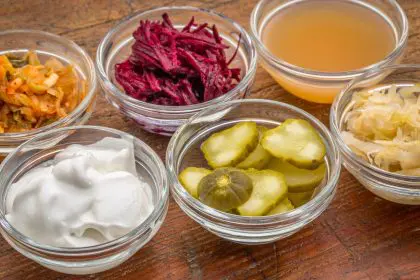Most people know fiber helps keep digestion running smoothly, but exciting new research suggests this humble nutrient does far more than prevent constipation. Scientists have discovered impressive connections between fiber consumption and brain function, adding to its already well-documented benefits for weight management. With a staggering 95% of Americans failing to meet recommended daily fiber intake, these findings offer compelling reasons to reconsider what many experts now call an overlooked nutritional powerhouse.
The fiber revolution extends beyond digestive health
For decades, doctors have recommended fiber primarily for digestive regularity and heart health. Recently, however, fiber has garnered attention during the popularity of weight loss medications like Ozempic, as health experts note its natural ability to promote feelings of fullness and support weight management goals. This connection makes sense given fiber’s physical properties—it absorbs water, adds bulk without calories, and slows digestion, helping people feel satisfied longer after meals.
What’s truly revolutionary, though, is the emerging evidence linking fiber consumption to cognitive function. This connection builds on growing scientific understanding of the gut-brain axis, the bidirectional communication network connecting our digestive and nervous systems. This research area suggests that what happens in our intestines significantly impacts our mental processes, mood, and overall brain health.
For individuals seeking both physical and mental vitality, increasing fiber intake offers a surprisingly simple dietary adjustment with potentially far-reaching benefits. Unlike many health interventions requiring substantial lifestyle changes or expensive supplements, fiber comes packaged in many everyday foods and affordable supplement options.
New research connects fiber intake with improved brain function
A groundbreaking randomized controlled trial published in Nature Communications has produced compelling evidence for fiber’s cognitive benefits. Researchers found that participants taking daily fiber supplements for 12 weeks demonstrated measurable improvements in brain function compared to those receiving placebo treatments. These improvements weren’t subtle—participants showed enhanced reaction times and faster information processing speeds, both crucial components of cognitive performance.
Supporting these human findings, animal studies reveal even more dramatic potential benefits. Research examining psyllium husk, a popular fiber supplement, indicates it may help reduce white matter damage in the brain. This finding holds particular significance because white matter damage contributes to cognitive decline and dementia development. While human studies must confirm these results, they suggest fiber might play a protective role against age-related cognitive deterioration.
The mechanism connecting gut health to brain function involves more than just nutrient absorption. Dr. Clifford Segil, a neurologist at Providence Saint John’s Health Center, notes that patients with digestive problems frequently report neurological symptoms like headaches and brain fog. This clinical observation supports the scientific evidence pointing to intimate connections between digestive processes and brain health.
The science behind fiber’s filling effects
Fiber has earned attention during the recent popularity of weight management medications because it naturally creates many similar digestive effects. When fiber-rich foods enter the digestive system, they absorb water and expand, creating physical fullness without adding significant calories. Additionally, fiber slows digestion, extending the release of nutrients and helping stabilize blood sugar levels rather than causing rapid spikes and crashes.
These properties explain why nutritionist Jessica Cording refers to certain fiber supplements like psyllium husk as “nature’s Ozempic.” While this comparison simplifies complex physiological processes, it highlights fiber’s natural ability to enhance satiety—the pleasant feeling of fullness that helps prevent overeating. For those seeking weight management support without medication, increasing fiber intake offers a practical first step.
Beyond immediate fullness, fiber supports weight management through additional mechanisms. It feeds beneficial gut bacteria that produce short-chain fatty acids, compounds that help regulate appetite hormones. Fiber-rich foods also typically require more chewing, slowing eating pace and allowing the body’s natural fullness signals to register before overconsumption occurs.
Psyllium husk emerges as a star player in fiber supplementation
Among various fiber sources, psyllium husk has gained particular attention for its versatility and effectiveness. This soluble plant fiber, derived from the seeds of the Plantago ovata plant, transforms dramatically when mixed with water. It quickly forms a gel-like substance that provides multiple health benefits as it moves through the digestive tract.
Psyllium’s gel-forming property makes it exceptionally effective for promoting regularity and addressing both constipation and diarrhea. This same characteristic creates the sensation of fullness that supports weight management efforts. Additionally, psyllium binds to cholesterol in the digestive system, helping transport it out of the body rather than allowing absorption into the bloodstream.
For those new to fiber supplements, starting gradually proves essential. Nutrition experts recommend beginning with small amounts—typically half a teaspoon mixed in water—and slowly increasing intake as the digestive system adjusts. This cautious approach helps prevent common side effects like bloating and gas that sometimes discourage people from continuing supplementation.
Ten fiber-rich foods to incorporate in your daily meals
While supplements offer convenience, whole foods provide fiber alongside additional nutrients and phytochemicals that support overall health. According to the Dietary Guidelines for Americans, these ten foods rank among the best natural fiber sources:
- Bran cereal leads the pack with approximately 10 grams per serving, offering an efficient way to boost morning fiber intake while providing essential B vitamins and minerals.
- Lima beans deliver about 7 grams of fiber per cup alongside plant-based protein, making them an excellent addition to soups and side dishes for sustained energy.
- Artichokes contain 6.5 grams per medium vegetable, along with antioxidants that support liver function and digestive health beyond their fiber content.
- Lentils provide 6 grams per half-cup serving and cook more quickly than other legumes, making them practical for weeknight meals when combined with various spices and vegetables.
- Guava offers 5 grams per fruit with additional vitamin C and antioxidants, creating a sweet option for boosting fiber intake while satisfying dessert cravings.
- Broccoli delivers 5 grams per cup with cancer-fighting compounds, representing one of the most nutrient-dense fiber sources available in the produce section.
- Raspberries contain 4 grams per half-cup serving alongside polyphenols that support overall cellular health, making them perfect for topping yogurt or oatmeal.
- Popcorn provides 3.5 grams per 3-cup serving when air-popped, offering a satisfying snack option that supports both fiber intake and snacking enjoyment.
- Cooked bulgur wheat delivers 4 grams per half-cup serving with a nutty flavor that works well in grain bowls and as a base for veggie-packed salads.
- Pumpkin seeds contain 3 grams per quarter-cup with additional magnesium and zinc, creating a crunchy topping for salads or yogurt that boosts multiple nutrients simultaneously.
Incorporating these foods regularly helps bridge the fiber gap without requiring drastic dietary overhauls. Even adding two or three higher-fiber options daily can significantly increase total intake.
How much fiber should you aim for daily?
Current dietary guidelines recommend adults consume approximately 28 grams of fiber daily, though specific needs vary somewhat by age, gender, and individual health conditions. Despite this relatively modest target, most Americans consume less than 15 grams daily, creating a significant nutrition gap with potential health consequences.
Achieving optimal fiber intake requires intentionality but not necessarily complicated diet plans. Simple swaps like choosing whole grain bread over white varieties, adding beans to salads, or including fruit with breakfast can substantially increase daily consumption. For those struggling to meet requirements through diet alone, supplements offer a practical solution.
When increasing fiber intake, gradual changes prevent digestive discomfort. Nutritionists recommend stepping up consumption over several weeks while simultaneously increasing water intake. This approach allows the digestive system to adjust to handling additional fiber without experiencing bloating or gas that might otherwise discourage continued efforts.
Beyond psyllium: alternative fiber supplements to consider
While psyllium husk receives considerable attention, several other supplement options provide different benefits and may better suit certain preferences:
Chia seeds offer a versatile fiber source that can be sprinkled on foods or mixed into beverages. These tiny seeds absorb water and create a gel similar to psyllium while adding omega-3 fatty acids not found in many other fiber supplements. Their mild taste makes them particularly suitable for adding to smoothies or overnight oat recipes.
Chicory root fiber, also known as inulin, feeds beneficial gut bacteria particularly effectively. This prebiotic fiber supports the microbiome—the community of beneficial organisms living in the digestive tract. Many manufacturers add chicory root to foods for fiber enrichment because it blends easily without significantly changing taste or texture.
Acacia fiber dissolves completely in liquids without thickening, making it ideal for those who dislike psyllium’s gel-forming properties. This gentle fiber option causes less bloating than some alternatives, making it suitable for people with sensitive digestive systems.
For those seeking convenience, several well-regarded commercial products combine these fiber types with flavorings or additional nutrients:
NOW Psyllium Husk Powder offers an unflavored option that can be added to beverages or soft foods, providing flexibility for those who prefer incorporating supplements into existing meals rather than taking them separately.
Metamucil 3-in-1 Psyllium Husk Fiber Supplement combines fiber with flavorings that make daily consumption more enjoyable. Beyond digestive benefits, this product has shown effectiveness for maintaining healthy blood sugar levels when taken before meals.
O Positiv GOGO Fiber Gummies provide fiber from chicory root in a chewable format that appeals to those who dislike mixing powders. These candy-like supplements make consistent fiber supplementation more accessible for people who struggle with traditional supplement forms.
The connection between fiber and other health conditions
Beyond weight management and brain function, fiber offers protective benefits against multiple chronic conditions. Research consistently shows that adequate fiber intake correlates with reduced risk of developing type 2 diabetes by moderating blood sugar spikes after meals. The steady energy release from fiber-rich foods helps maintain insulin sensitivity over time.
Cardiovascular health improvements stem from fiber’s ability to bind with cholesterol particles in the digestive tract, preventing their absorption into the bloodstream. This mechanism explains why fiber supplementation frequently appears in heart health protocols alongside other lifestyle modifications.
Digestive conditions like diverticulosis benefit significantly from increased fiber intake. By adding bulk to stool and supporting regular bowel movements, fiber reduces pressure within the colon that might otherwise lead to developing small pouches (diverticula) in the intestinal wall.
Emerging research suggests fiber may also play a role in cancer prevention, particularly colorectal cancer. By speeding transit time through the digestive tract, fiber reduces exposure to potential carcinogens. Additionally, when gut bacteria ferment certain fibers, they produce compounds that appear to protect against cellular changes associated with cancer development.
Why most Americans miss the mark on fiber intake
Despite fiber’s numerous health benefits, most Americans consume less than half the recommended amount. Several factors contribute to this nationwide deficiency:
Processed food prevalence in the American diet creates a significant barrier, as manufacturing processes often remove natural fiber to improve shelf life and texture. Even products advertised as “made with whole grains” frequently contain minimal fiber after processing.
Misconceptions about carbohydrates have led many dieters to avoid fiber-rich foods like whole grains, beans, and fruits in attempts to reduce carb intake. This approach sacrifices beneficial fiber along with the simple carbohydrates they aim to limit.
Convenience-focused eating patterns favor quick, ready-to-eat options that typically contain minimal fiber. The time required to prepare whole foods represents a barrier for many busy individuals and families juggling multiple responsibilities.
Addressing these challenges requires both individual awareness and broader food system changes. For individuals, understanding fiber’s health benefits provides motivation to overcome these barriers through intentional food choices and supplement use when necessary.
As research continues to reveal connections between fiber intake, brain health, and disease prevention, interest in this once-overlooked nutrient continues growing. What makes fiber particularly valuable in today’s health landscape is its accessibility—unlike many trendy supplements with limited research backing, fiber’s benefits come supported by decades of scientific evidence and availability in ordinary foods found in any grocery store. Whether through dietary changes, supplements, or a combination approach, increasing fiber consumption represents one of the simplest yet most effective steps toward improved overall health.
















